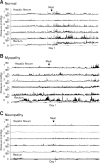How to perform and assess colonic manometry and barostat study in chronic constipation
- PMID: 25230902
- PMCID: PMC4204415
- DOI: 10.5056/jnm14056
How to perform and assess colonic manometry and barostat study in chronic constipation
Abstract
Management of chronic constipation with refractory symptoms can be challenging. Although new drugs and behavioral treat-ments have improved outcome, when they fail, there is little guidance on what to do next. At this juncture, typically most doc-tors may refer for surgical intervention although total colectomy is associated with morbidity including complications such as recurrent bacterial overgrowth. Recently, colonic manometry with sensory/tone/compliance assessment with a barostat study has been shown to be useful. Technical challenges aside, adequate preparation, and appropriate equipment and knowledge of co-lonic physiology are keys for a successful procedure. The test itself appears to be safe with little complications. Currently, colon-ic manometry is usually performed with a 6-8 solid state or water-perfused sensor probe, although high-resolution fiber-optic colonic manometry with better spatiotemporal resolutions may become available in the near future. For a test that has evolved over 3 decades, normal physiology and abnormal findings for common phenotypes of chronic constipation, especially slow transit constipation, have been well characterized only recently largely through the advent of prolonged 24-hour ambulatory colonic manometry studies. Even though the test has been largely restricted to specialized laboratories at the moment, emerg-ing new technologies and indications may facilitate its wider use in the near future.(J Neurogastroenterol Motil 2014;20:547-552).
Keywords: Barostat; Colon; Constipation; Manometry.
Figures



Similar articles
-
Clinical utility of colonic manometry in slow transit constipation.Neurogastroenterol Motil. 2013 Jun;25(6):487-95. doi: 10.1111/nmo.12092. Epub 2013 Feb 6. Neurogastroenterol Motil. 2013. PMID: 23384415 Free PMC article.
-
Clinical utility of colonic and anorectal manometry in chronic constipation.J Clin Gastroenterol. 2010 Oct;44(9):597-609. doi: 10.1097/MCG.0b013e3181e88532. J Clin Gastroenterol. 2010. PMID: 20679903 Review.
-
Ambulatory 24-hour colonic manometry in slow-transit constipation.Am J Gastroenterol. 2004 Dec;99(12):2405-16. doi: 10.1111/j.1572-0241.2004.40453.x. Am J Gastroenterol. 2004. PMID: 15571589
-
A patient with localized megacolon and intractable constipation: evidence for impairment of colonic muscle tone.Am J Gastroenterol. 1994 Oct;89(10):1867-70. Am J Gastroenterol. 1994. PMID: 7942685
-
High resolution colonic manometry--what have we learnt?--A review of the literature 2012.Curr Gastroenterol Rep. 2013 Jun;15(6):328. doi: 10.1007/s11894-013-0328-2. Curr Gastroenterol Rep. 2013. PMID: 23709203 Review.
Cited by
-
Clinical Evaluation of a Patient With Symptoms of Colonic or Anorectal Motility Disorders.J Neurogastroenterol Motil. 2020 Sep 30;26(4):423-436. doi: 10.5056/jnm20012. J Neurogastroenterol Motil. 2020. PMID: 32989182 Free PMC article. Review.
-
Personalized medicine in functional gastrointestinal disorders: Understanding pathogenesis to increase diagnostic and treatment efficacy.World J Gastroenterol. 2019 Mar 14;25(10):1185-1196. doi: 10.3748/wjg.v25.i10.1185. World J Gastroenterol. 2019. PMID: 30886502 Free PMC article. Review.
-
Effectiveness of Abdominal Functional Electrical Stimulation for Improving Bowel Function in People With a Spinal Cord Injury: A Study Protocol for a Double-Blinded Randomized Placebo-Controlled Clinical Trial.Top Spinal Cord Inj Rehabil. 2022 Fall;28(4):22-31. doi: 10.46292/sci22-00008. Epub 2022 Nov 15. Top Spinal Cord Inj Rehabil. 2022. PMID: 36457354 Free PMC article.
-
Organizing and Developing a GI Motility Lab in Community Practice: Challenges and Rewards.Curr Gastroenterol Rep. 2022 Jun;24(6):73-87. doi: 10.1007/s11894-022-00838-5. Curr Gastroenterol Rep. 2022. PMID: 35674875 Review.
-
Intraluminal pressure patterns in the human colon assessed by high-resolution manometry.Sci Rep. 2017 Feb 20;7:41436. doi: 10.1038/srep41436. Sci Rep. 2017. PMID: 28216670 Free PMC article.
References
-
- Bampton PA, Dinning PG. High resolution colonic manometry--what have we learnt?–A review of the literature 2012. Curr Gastroenterol Rep. 2013;15:328. - PubMed
-
- Dinning PG, Wiklendt L, Gibbins I, et al. Low-resolution colonic manometry leads to a gross misinterpretation of the frequency and polarity of propagating sequences: initial results from fiber-optic high-resolution manometry studies. Neurogastroenterol Motil. 2013;25:e640–e649. - PubMed
-
- Camilleri M, Bharucha AE, di Lorenzo C, et al. American Neurogastroenterology and Motility Society consensus statement on intraluminal measurement of gastrointestinal and colonic motility in clinical practice. Neurogastroenterol Motil. 2008;20:1269–1282. - PubMed
LinkOut - more resources
Full Text Sources
Other Literature Sources

